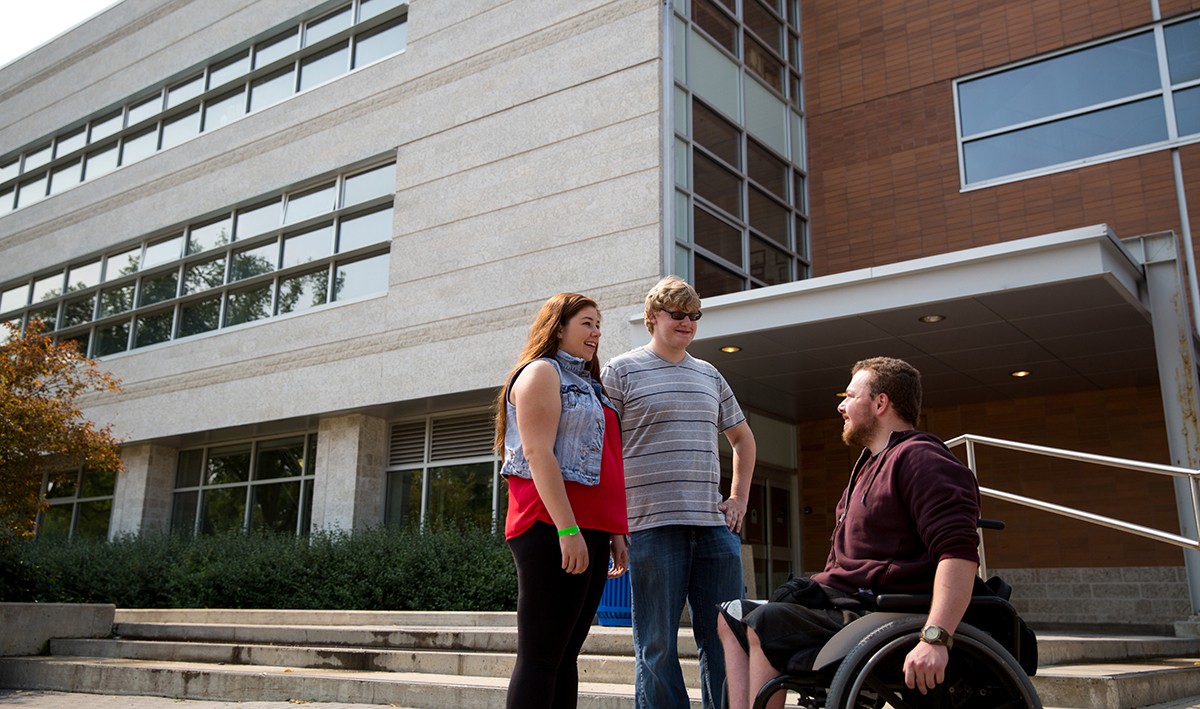
University of Manitoba students.
Identifying barriers to accessibility at the U of M: Survey results
Results of the U of M’s accessibility survey initiated by the University’s Human Rights and Conflict Management Office in May are now available.
The response rates were high, with a total of 556 respondents, split between faculty (83 at 15%), staff (271 at 49%) and students (138 at 25%). 111 (11%) chose not to identify in any of those three categories.
The survey results showed a reoccurring theme of acknowledgement of the positive efforts in accommodations that removed barriers, says Krystyl Bergen, the U of M’s accessibility coordinator and accessibility workshop leader.
“Survey respondents mentioned examples ranging from workplace accommodations to inclusive and accessible learning environments and university wide initiatives with compliance of the AMA, among others,” she says.
“People also told us that they appreciated the great supports of Campus life, Employee Wellness, Student Accessibility Services, and one-on-one instructor supports throughout both campuses.”
The survey results will inform our plan to identify, prevent and remove barriers to accessibility at the U of M, a plan legally required to be published in December 2016 as part of the Accessibility for Manitobans Act (AMA), which became law in December 2013. The University of Manitoba is committed to creating an inclusive and accessible community for all faculty, students and staff.
The AMA will be implemented over time and includes five main standards with individual time frames, to be addressed in order: customer service, employment, information and communication, transportations and built environment.
The survey invited the university community to provide feedback on any barriers to accessibility in our work and learning environment. All suggestions will be considered in the University’s objective of identifying ways we can improve our organization, building upon our goals as identified in the U of M’s strategic plan, of providing accessibility and reasonable accommodation.
ACCESSIBILITY SURVEY RESULTS
The survey yielded a total of 556 respondents, split between faculty (83 at 15%), staff (271 at 49%) and students (138 at 25%). 111 (11%) chose not to identify in any of those three categories.
Following are the original questions from the survey, along with survey results.
1. Considering a very broad range of needs and abilities, I feel that I am a person with a disability that requires an accommodation.
Yes – 120 people, 21.6%
No – 436 people 78.4
Question 1 Comment Themes:
-Temporary vs. permanent disability
-Physical
-Visual
-Mental health = all ranging
-Hearing
-Accommodation
2. I have experienced or witnessed attitudinal barriers.
[Strongly Agree, Agree, Neither Agree nor Disagree, Disagree, Strongly Disagree]
Strongly Agree 74
Agree 207
Neither Agree Nor Disagree 104
Disagree 88
Strongly Disagree 37
3. I have experienced or witnessed informational and communication barriers.
[Strongly Agree, Agree, Neither Agree nor Disagree, Disagree, Strongly Disagree]
Strongly Agree 56
Agree 221
Neither Agree Nor Disagree 109
Disagree 72
Strongly Disagree 31
4. I have experienced or witnessed technological barriers.
[Strongly Agree, Agree, Neither Agree nor Disagree, Disagree, Strongly Disagree]
Strongly Agree 55
Agree 177
Neither Agree Nor Disagree 124
Disagree 97
Strongly Disagree 29
5. I have experienced or witnessed systemic barriers.
[Strongly Agree, Agree, Neither Agree nor Disagree, Disagree, Strongly Disagree]
Strongly Agree 137
Agree 194
Neither Agree Nor Disagree 64
Disagree 53
Strongly Disagree 29
Questions 2-5: Comment Themes
Major themes included:
-Attitudes (38 comments)
-Elevators (20)
-Navigation between buildings -> inside and out (18)
-Washrooms and Accessible Washrooms (18)
-Accessibility for classrooms (for students and instructors) and Lecture theatres (16)
-Websites (15)
-Old buildings (15)
Other themes that emerged: accessible doors or lack thereof (13); education (11); accommodation (10); better planning (10) inaccessible documents (10); positive experiences (8); assumptions made (7); mental health and lack of knowledge (8); snow and ice clearing and winter accessibility (5); accessible parking (5); scents (4); policy (3).
Overall in Questions 2-5 comments, attitudes and physical and architectural barriers were the most commonly discussed.
6. Question 6: Select your top 3 priorities for our accessibility plan:
[Attitudinal Barriers, Information and Communication Barriers, Physical and Architectural Barriers, Systemic Barriers, Technological Barriers]
Student Priority #1: Physical & Architectural 33.59%
Student Priority #2: Information and Communication 31%
Student Priority #3: Technological
Staff Priority #1: Physical and Architectural 47%
Staff Priority #2: Information and Communication 29%
Staff Priority #3: Technological 22%
Faculty Priority #1: Physical and Architectural 49%
Faculty Priority #2: Info and Communication 30%
Faculty Priority #3: Technological 25%
Overall Priorities:
#1: Physical and Architectural 43%
#2: Info and communication 29%
#3: Technological 22%
Demographics:
31 people identified themselves as students and staff
5 identified as staff and faculty
1 identified as student and faculty
1 identified as students, staff and faculty
For further information about accessibility at the U of M, go to: http://news.umanitoba.ca/the-accessibility-for-manitobans-act-at-the-u-of-m/
Read more here: news.umanitoba.ca/planning-for-accessibility-beyond-the-law/
and here: news.umanitoba.ca/planning-for-accessibility-resources/
Also see more on the Accessibility for Manitobans Act (AMA)
Join the discussion on accessibility at the Visionary Conversations event on Thursday, Dec. 8, 2016 at the Robert B. Schultz Theatre, St John’s College, Fort Garry campus.







